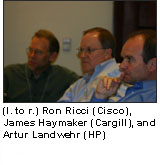
|
|
|
 |
|
 |
Managing the Organizational Impact of Global Operations
Thought Leadership Summit on Digital Strategies October 2004 - Santa Barbara, CA CIOs and other senior execs from Cargill, Cisco, Eaton, General Motors, Hasbro, HP, IBM, and Whirlpool were joined by academics from Tuck and Wharton for this roundtable. This event was the eighth summit in the Thought Leadership Summit on Digital Strategies series. |
||
|
Press Release
Agenda
List of Participants
Discussion Guide
Overview Article
|
|||||
In addition, the world has changed for all of us, demanding: (i) higher productivity with fewer people; (ii) process standardization with more customized products; and (iii) increased information sharing with greater security; and all in a global environment that has become less predictable and sure.
This summit discussed the business, economic and cultural impacts on companies who are managing their businesses, their processes, their resources and their investments across the globe. By examining the processes of global operations management and sharing best practices, this roundtable produced the following key observations:
- Leading globalization today increasingly means encouraging multi-faceted capabilities rather than a one-world focus. The idea of the single product, the single customer and the single policy is largely a myth.
- Successful globalization requires 80% common processes, policies and platforms - this sets the stage for and enables the 20% differentiation that creates competitive advantage through multi-faceted capabilities.
- Choosing the 20% that should be differentiated should be guided by a clear understanding of what is core vs. context for a company, and what is mission critical and what not. The greatest room for variance and differentiation should be allowed where core meets mission critical - the least, where context meets non-mission critical.
- Execution is critical, especially when you are spread over the globe. Building and maintaining the 80/20 focus requires relentless change management, using data to change behaviors and enabling both regional and functional enfranchisement.
- Creating the climate for change throughout the organization is not easy. On a global scale, it requires a real understanding of the culture of the company as a whole, but also of the regional and functional subcomponents, and the willingness to appropriately drive Dissatisfaction x Vision x First steps to be greater than the Resistance (DVF>R) for each subunit.
- The key future globalization challenges can be summarized in three words: contingencies, commoditization and customization; contingency preparation for dealing with the unexpected and unpredictable, commoditization as the predictable enemy of profit margins and customization as the response to commoditization. Increasingly this customization will happen through tailored services enabled by the 20% differentiation.
![]()
| M. Eric Johnson shares his thoughts on globalization and collaboration in "A Travel Guide to Collaboration," CIO Magazine | |
| "Running a Global Company Well Poses Major Operational Challenges," Knowledge@Wharton | |
| "Technology, Globalization, and Policy at a Crossroads" - a Supply Chain Thought Leaders Roundtable | |
| To link to the Thought Leadership Summit on Digital Strategies website, click here. | |